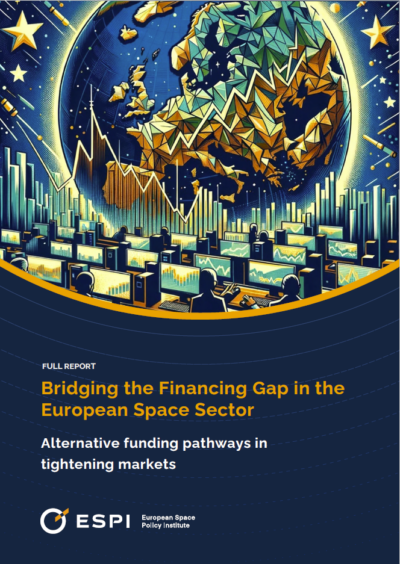Executive Brief No.9
The European space industry is at a disadvantage to its international competitors that are backed by massive institutional programmes and R&T funding, are less dependent on commercial sales, and have formed robust synergies between civil and defence sectors. What’s more, those competitors are bringing new innovation and commercial challenges, by applying aggressive strategies in both manufacturing processes and business models, which are changing the nature of competition. If European space sector hopes to maintain its industry’s competitiveness, it will need to have the right framework to meet these new challenges, reallocate the shared risksbetween public and private actors, and form a long-term vision on the drivers in space activity to remain ahead of the curve in space technologies and services.
1. Europe’s technology policy
For Europe to become a leader in space innovation it needs to develop a mechanism for technology maturation; i.e. it needs to have the right framework in place to bring a sufficient level of maturityto technologies, in terms of having the right capability, level of performance, non-dependence in components, and at affordable economic conditions. Many of ESA or EC’s Space Research and Technology programmes such as TRP1 are good steps in that direction but they are most often focused on developing preliminary concepts. In order for those technologies to reach maturity theyfirst must be brought within an application or operational programme. What is missing is analternative way for Europe’s space industry to demonstrate new technologies in orbit to address new and emerging markets.
Europe would benefit from having an institutionally funded agency to expand the frontiers of technology and science, similar to how the U.S. Defense Advanced Research Projects Agency (DARPA) helps to incubate technologies that are later picked up by NASA when it suits their mission objectives. DARPA, founded in response to the launch of Sputnik in 1957 to ensure that the U.S. would be the initiator and not the victim of strategic technological surprises, is a well-established mechanism for maturing technologies. Funded by the U.S. Department of Defense (DoD), DARPA acts as an institutional anchor customer for the development of game-changing technologies whose applications might extend beyond military uses, such as with its development of the ARPANET platform – one of the precursors to the internet. Such an institution would likewise aide the EU’s Global Strategy on Foreign and Security Policy, where issues of space and security are converging.
2. Risk sharing schemes between public and private institutions
European institutions have shied away from sharing market risk with industry, preferring instead to invest in the development of space systems that bring quick returns on investment. Paradoxically,beyond feasibility studies and demonstrations within the ESA ARTES programme, commercial operations are not facilitated. To enter the commercial market, European companies often must turn to the private sector to help shoulder the risk; here, many European investors and venture capitalists still shaking off the consequences of the last financial crisis.
That barrier to entry is much lower in the U.S. because its public actors have a larger appetite for amortizing the investments and sharing risks with private companies to the point where they can be successful in the market. For instance, the U.S. DoD has increasingly used microsatellites to conduct research and test new technologies, while in Europe its development is relatively absent. Another poignant example comes from SpaceX’s Falcon 9 launcher whose continued U.S. institutional support has insulated the company from market forces. While reusable launch capability is in no way beyond the means of Europe’s space industry, it has consistently determined that there is no reason to expect that reusable launchers will bring a cost benefit especially when considering the level of institutional spending in Europe. Rather than share the risk with industry only in the development phase, Europe’s public sector should take further steps in helping to sharemarket risks with industry by creating a stronger institutional market.
3. Projecting ourselves in a long-term vision
Steps to better position Europe’s space sector globally are being considered by the European Union in its recently published Space Strategy. Yet, Europe is also in need of a long-term vision for its space sector; otherwise, the new technologies and capabilities its space industry creates could be exploited by strong international competitors before they can be enjoyed by Europeans. For instance, while Europe considers how to reap the benefits of the data and signals it makes available through its Copernicus and Galileo systems in its Horizon 2020 Space Work Programme 2016-2017, technology giants Google, Amazon, Facebook, Apple (GAFAs) are ready to commercialize that data based on demand.
While Europe’s space sector focuses on the early 2020s, the U.S. and other large space actors are looking into the distant horizon with human missions to Mars and space commercialization. If Europe hopes to maintain its competitiveness beyond the 2030s, it needs to form its own vision for the types of markets that will exist at that time, and to create a European-wide mechanism to enable these technologies to bloom. Otherwise technologies for deep space exploration, space resources exploitation, and developing space structures on the Moon will remain just concepts for Europe’s space industry, and a fully realised capability for Europe’s competitors.
References
1 “About the Technology Research Programme (TRP).” 9 Feb. 2017. ESA 15 Feb. 2017 <http://www.esa.int/Our_Activities/Space_Engineering_Technology/Shaping_the_Future/About_the_Technology_Research_Programme_TRP>




